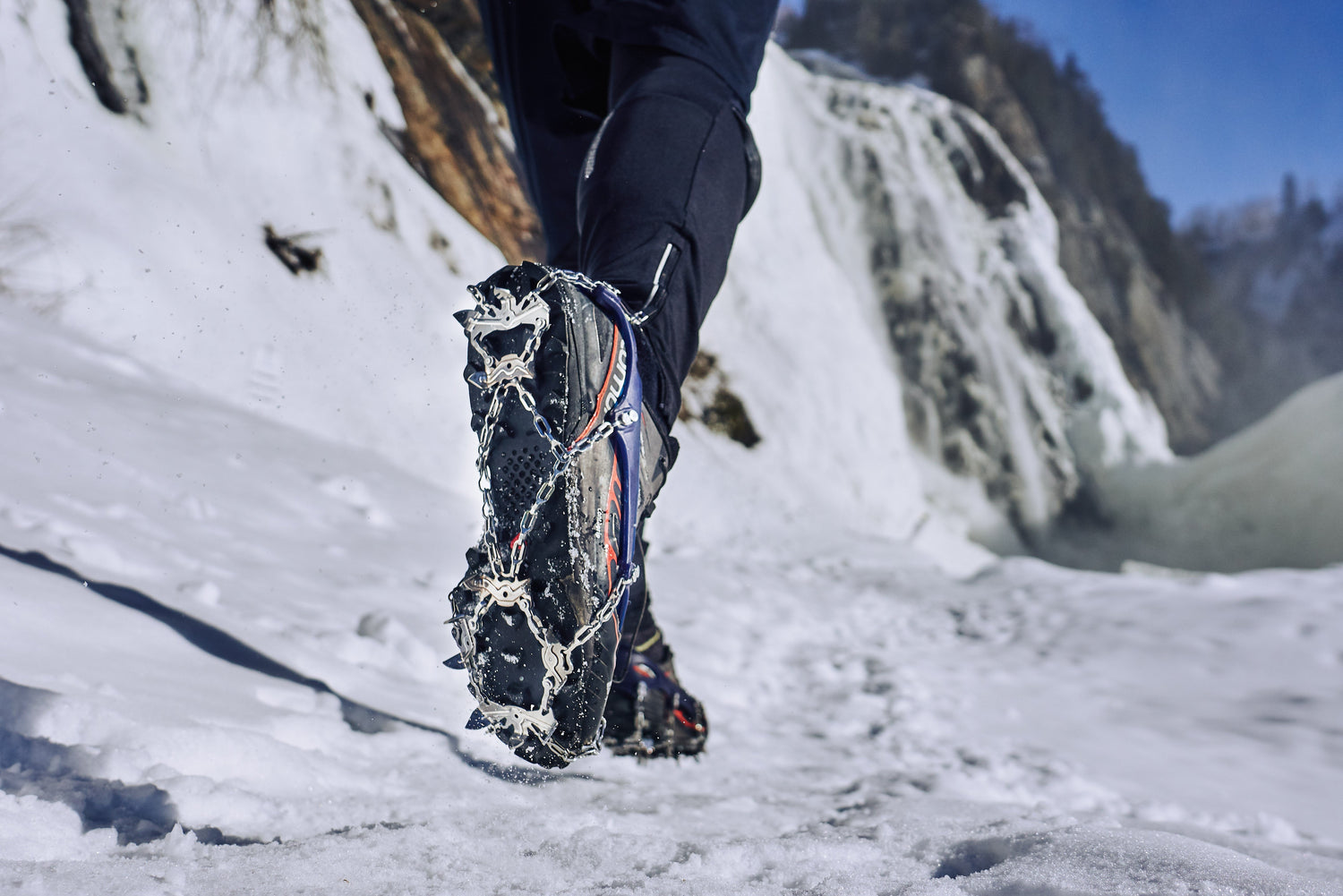Crampons are metal spikes that attach to your boots and provide traction on ice and snow. They are essential for anyone hiking in winter conditions or on glaciers. Crampons come in various designs, tailored to different activities and terrain types, from gentle snowfields to steep ice climbs.
Historical Background
The use of crampons dates back centuries when early climbers and mountaineers needed reliable traction on ice. Originally, they were simple iron spikes that could be tied to shoes or boots. Over time, designs evolved to become more efficient and user-friendly. Understanding their historical development can provide insight into how modern innovations have improved safety and performance.
Modern Designs
Today's crampons are the result of years of innovation and technology. They are made using high-quality materials that ensure durability and performance in harsh conditions. Modern designs focus not only on functionality but also on comfort, ease of use, and adaptability to different footwear. This makes them suitable for a wide range of outdoor activities beyond just hiking, such as ice climbing and mountaineering.
Importance in Outdoor Activities
Crampons are not just for professional climbers; they are a critical tool for any outdoor enthusiast venturing into snowy or icy environments. They provide the necessary traction to prevent slips and falls, which are common and dangerous in such conditions. By using crampons, hikers can confidently tackle challenging terrains, ensuring both safety and enjoyment.
Types of Crampons
Choosing the right crampons largely depends on the type of hiking or climbing you'll be doing. Let's explore the main types of crampons available.
Strap-On Crampons
Strap-on crampons are versatile and can be attached to almost any type of boot. They use nylon webbing straps to secure the crampon to your foot. This makes them a great choice for beginners or those who don't have specialized boots. However, they might not provide the same level of stability as other types.
Versatility of Strap-On Crampons
One of the key benefits of strap-on crampons is their ability to fit nearly any boot, making them highly versatile. This adaptability is particularly useful for those who enjoy multiple outdoor activities and use different types of footwear. Whether you're snowshoeing, hiking, or exploring less technical trails, strap-on crampons can be a reliable option.
Ease of Use
For beginners, the straightforward design of strap-on crampons is a significant advantage. They are easy to put on and take off, which is especially beneficial in cold conditions when speed is essential. The learning curve is minimal, making these crampons ideal for those new to winter hiking.
Considerations for Stability
While versatile, strap-on crampons may not offer the same level of stability as other types. This can be a concern in more challenging terrains where secure footing is critical. Therefore, understanding the limitations of strap-on crampons is vital to ensure they are used appropriately and safely.
Step-In Crampons
Step-in crampons, also known as automatic crampons, require boots with specific heel and toe welts for attachment. They are favored by mountaineers for their secure fit and quick attachment. If you're planning on tackling more technical climbs, these might be the best choice for you.
Secure Fit Advantage
The primary advantage of step-in crampons is their secure fit. The attachment system ensures that the crampon stays firmly in place, even in the most demanding conditions. This security is crucial for mountaineers and technical climbers who require maximum reliability from their gear.
Quick Attachment Mechanism
In challenging environments, the ability to quickly attach and detach crampons can make a significant difference. Step-in crampons excel in this regard, allowing users to transition smoothly between different terrains. This efficiency can save time and reduce exposure to cold temperatures during gear adjustments.
Boot Compatibility
It's important to note that not all boots are compatible with step-in crampons. They require specific designs with toe and heel welts to attach correctly. Ensuring that your boots are compatible before purchasing step-in crampons is essential to avoid issues in the field.
Hybrid or Semi-Automatic Crampons
Hybrid crampons, or semi-automatic crampons, combine features of strap-on and step-in crampons. They use a heel lever and a toe strap, offering a blend of flexibility and security. This type is ideal for those who may switch between different types of terrain and need a versatile option.
Blend of Features
The hybrid design provides a balance between the security of step-in crampons and the versatility of strap-on models. This combination makes them suitable for a wide range of activities, from general hiking to more technical climbs. Users can enjoy the benefits of both systems in one product.
Versatile Terrain Usage
Hybrid crampons are particularly beneficial for those who encounter varied terrains on their adventures. They can easily transition from flat, icy paths to steeper, more technical routes. This adaptability allows hikers to tackle diverse challenges without needing multiple pairs of crampons.
Boot Compatibility and Flexibility
While more flexible than step-in crampons, hybrid models still require some specific boot features for optimal performance. However, they are generally more accommodating than fully automatic systems. Understanding the compatibility requirements can help ensure a proper fit and secure attachment.
Key Features to Consider
When choosing crampons for hiking, there are several key features to consider:
Material
Crampons are made from either steel or aluminum. Steel crampons are durable and best suited for rugged, icy conditions. Aluminum crampons are lighter but less durable, making them a good option for less technical hikes.
Steel Crampons
Steel crampons are known for their strength and durability, making them ideal for challenging conditions. They can withstand the rigors of ice and rock, providing reliable performance in harsh environments. For those venturing into demanding terrains, steel crampons offer the assurance of longevity and resilience.
Aluminum Crampons
In contrast, aluminum crampons are much lighter, which can be a significant advantage on longer hikes where every ounce matters. They are well-suited for less technical trails and softer snow conditions. However, their reduced durability means they may not be the best choice for rocky or extremely icy surfaces.
Choosing Based on Activity
Selecting the right material largely depends on the type of activity and conditions you expect to encounter. For high-altitude mountaineering, steel is often preferred, while for general winter hiking or snowshoeing, aluminum can be sufficient. Evaluating your specific needs will guide you to the best choice.
Number of Points
Crampons typically have between 10 to 14 points, with more points providing better traction. For general hiking, 10-point crampons are usually sufficient. However, if you plan on doing more technical climbs, consider 12 or 14-point crampons for added security.
Understanding Point Configuration
The configuration and number of points on a crampon can significantly influence performance. More points generally mean increased traction, which is crucial on steep or icy surfaces. However, the added weight and complexity of additional points should be considered, especially for less technical hikes.
Traction and Stability
Increased traction from more points can enhance stability, offering greater security on challenging ascents and descents. For technical climbs, the added grip can make a critical difference in safety and performance. Evaluating the terrain and your comfort level can help determine the optimal number of points.
Balancing Weight and Performance
While more points can improve traction, they also add weight. For those embarking on long treks, balancing the need for stability with the desire to minimize weight is important. Understanding your priorities will help you select the most suitable crampon configuration.
Binding System
Consider the binding system that best suits your boots and hiking needs. Strap-on crampons are versatile, while step-in and hybrid crampons offer more security for technical routes.
Strap-On Versatility
The binding system's versatility is a key factor when choosing crampons. Strap-on systems are highly adaptable, fitting a wide range of boots, which is advantageous for those who use different footwear for various activities. This flexibility can be a significant asset for multi-sport outdoor enthusiasts.
Step-In Security
For those requiring maximum security, step-in bindings offer unparalleled stability. This system is favored by technical climbers who need their gear to perform flawlessly in demanding conditions. The secure fit ensures peace of mind when tackling challenging routes.
Hybrid Flexibility
Hybrid systems offer a compromise between versatility and security. They are suitable for a variety of terrains and boot types, providing both flexibility and a secure fit. This balance makes them an excellent choice for adventurers facing diverse conditions.
Anti-Balling Plates
Anti-balling plates prevent snow from building up under your crampons, which can be dangerous. Look for crampons with anti-balling plates if you expect to encounter wet snow conditions.
Importance of Anti-Balling Plates
Snow buildup, or balling, can seriously compromise traction and stability, making anti-balling plates a vital feature. These plates prevent snow from accumulating, ensuring consistent performance in snowy conditions. For those frequently encountering wet snow, this feature is indispensable.
Enhancing Safety
By preventing snow accumulation, anti-balling plates enhance safety, reducing the risk of slips and falls. This is particularly important in wet, heavy snow where balling is most likely to occur. Prioritizing crampons with this feature can significantly improve your hiking experience.
Compatibility and Integration
Not all crampons come with anti-balling plates, so it's important to verify their inclusion if needed. Some designs allow for aftermarket plate additions, providing flexibility for customization. Understanding the options available can help you make an informed decision.
How to Fit Crampons
Fitting crampons correctly is crucial for safety and performance. Here's how to ensure a proper fit:
Boot Compatibility
Ensure your boots are compatible with the type of crampons you choose. Step-in crampons require specific boots, while strap-on and hybrid crampons are more flexible.
Assessing Boot Features
Before selecting crampons, assess your boots for compatibility with different binding systems. Step-in crampons necessitate specific heel and toe welts, while strap-on and hybrid models are generally more forgiving. Understanding the features of your boots will guide you to the appropriate crampon type.
Customizing for Fit
Some crampons offer customizable features to better fit specific boot styles. These adjustments can enhance comfort and security, ensuring a snug and effective fit. Exploring these options can maximize performance and safety on the trail.
Test Before You Trek
Testing boot and crampon compatibility at home before heading out can prevent issues in the field. Practicing attachment and adjusting fit will ensure you're prepared for any conditions you might encounter. Taking the time to test your gear can save time and enhance safety during your hike.
Size Adjustment
Most crampons are adjustable. Make sure they fit snugly on your boots without being too tight. Your boots should feel secure but comfortable.
Understanding Adjustment Mechanisms
Crampons often come with adjustable features to accommodate different boot sizes. Familiarizing yourself with these mechanisms is important for achieving a proper fit. Ensuring your crampons are correctly adjusted will enhance both comfort and performance.
Achieving the Perfect Fit
A snug fit is essential for stability and safety, but it shouldn't compromise comfort. Adjust your crampons so they are secure without causing pressure points or discomfort. This balance is key to enjoying a safe and pleasant hiking experience.
Regular Fit Checks
It's wise to periodically check the fit of your crampons during a hike, as adjustments may be needed. Changing conditions or extended wear can affect the fit, so staying attentive can help maintain optimal performance. Regular checks ensure your gear continues to function effectively.
Practice Attachment
Before heading out, practice attaching and detaching your crampons. This will help you get familiar with the process and ensure you can do it quickly in cold conditions.
Building Familiarity
Practicing attachment and detachment of crampons before hitting the trail builds familiarity and confidence. Understanding the process thoroughly reduces the chance of errors in cold or challenging conditions. This practice is particularly important for beginners or those using new gear.
Speed and Efficiency
Being able to quickly attach and detach crampons is crucial in fluctuating conditions. Efficiency in this process can save valuable time and reduce exposure to cold weather. Developing these skills ensures you're well-prepared for any changes in terrain or conditions.
Troubleshooting Common Issues
Practice also provides an opportunity to identify and address any issues with your crampon setup. Troubleshooting in a controlled environment allows for adjustments without the pressure of being on the trail. This preparation ensures that you can handle any challenges with ease during your hike.
Caring for Your Crampons
To extend the life of your crampons, regular maintenance is essential:
Cleaning
After each use, clean your crampons with warm water to remove dirt and salt. Dry them thoroughly to prevent rust.
Importance of Post-Use Cleaning
Cleaning your crampons after each use is vital to prevent corrosion and maintain performance. Removing dirt, salt, and other debris ensures your gear remains in top condition. This simple routine can significantly extend the lifespan of your crampons.
Drying Techniques
Thorough drying after cleaning is crucial to prevent rust, especially if your crampons are made of steel. Air drying in a warm, dry place is ideal, but avoiding direct heat sources prevents potential damage. Proper drying techniques are an essential part of crampon maintenance.
Long-Term Care Benefits
Regular cleaning and drying not only prevent rust but also help you identify any wear or damage early. This proactive approach allows for timely repairs or replacements, ensuring your safety and performance are never compromised. Consistent care is key to preserving your investment.
Sharpening
Over time, the points may become dull. Use a file to sharpen them, ensuring better traction on future hikes.
Identifying Dull Points
Regular inspection of your crampons can help identify when sharpening is needed. Dull points can significantly reduce traction, so addressing this issue promptly is important. Recognizing the signs of wear will guide you in maintaining optimal performance.
Sharpening Techniques
Using a file to sharpen your crampons requires precision to maintain the correct angle and shape of the points. Following manufacturer guidelines ensures that you sharpen effectively without causing damage. Proper technique is crucial for restoring traction and extending the life of your crampons.
Frequency of Sharpening
How often you need to sharpen your crampons depends on usage and the terrains you encounter. Regularly used crampons on rocky surfaces may require more frequent sharpening. Monitoring wear and maintaining a sharpening schedule will keep your gear in peak condition.
Storage
Store your crampons in a dry place, away from direct sunlight. Consider using a protective case to prevent damage during transport.
Ideal Storage Conditions
Storing crampons in a dry, cool environment away from direct sunlight is essential to prevent deterioration. This environment minimizes the risk of rust and material degradation. Adopting proper storage habits ensures your crampons remain ready for future adventures.
Using Protective Cases
A protective case can prevent physical damage during transport and storage. These cases protect the points from dulling and the rest of your gear from potential damage. Investing in a quality case is a simple way to safeguard your crampons.
Long-Term Storage Tips
For long-term storage, especially in off-seasons, extra precautions can preserve your crampons. Cleaning, drying, and applying a light coating of oil can prevent rust during extended periods of inactivity. Proper long-term storage practices ensure your gear is ready when you need it.
Choosing the Right Crampons for Your Hike
When selecting crampons, consider the terrain and conditions you'll encounter. For general hiking in snowy conditions, strap-on or hybrid crampons are often sufficient. For more technical climbs or glacier travel, step-in crampons provide the security you need.
Assessing Terrain and Conditions
Understanding the terrain and conditions you expect to face is crucial in selecting the right crampons. Different environments present unique challenges, from icy paths to steep climbs. Evaluating these factors ensures your crampons meet your specific needs for safety and performance.
Matching Crampons to Experience Level
Your experience level should also influence your choice of crampons. Beginners may prefer the simplicity and versatility of strap-on models, while more experienced hikers might opt for step-in or hybrid crampons for advanced routes. Choosing based on experience ensures comfort and confidence in your gear.
Evaluating Budget and Quality
While budget is a consideration, investing in quality crampons can provide better performance and longevity. Higher-quality materials and construction often result in superior durability and safety features. Balancing cost with quality helps you select crampons that offer the best value for your needs.
Conclusion
Investing in the right pair of crampons is essential for anyone planning to hike in icy or snowy conditions. By understanding the types, features, and proper maintenance of crampons, you can ensure a safer and more enjoyable hiking adventure.
Whether you're a beginner or an experienced mountaineer, the right crampons will provide the traction you need to conquer challenging winter terrains. Choose wisely, and happy hiking!





Leave a comment
All comments are moderated before being published.
This site is protected by hCaptcha and the hCaptcha Privacy Policy and Terms of Service apply.